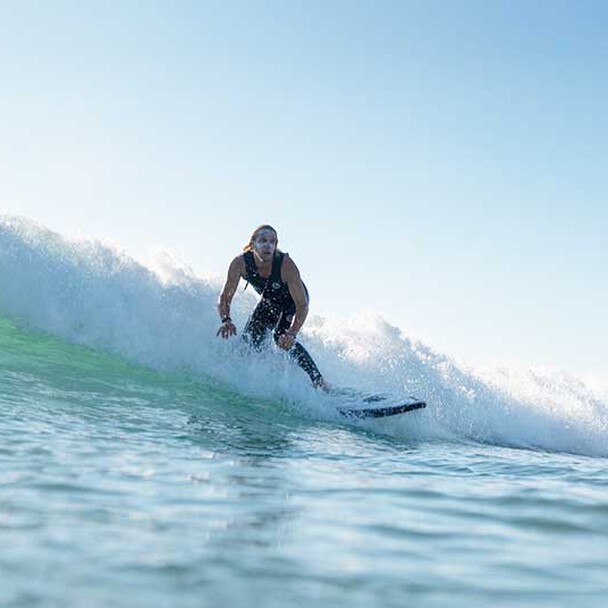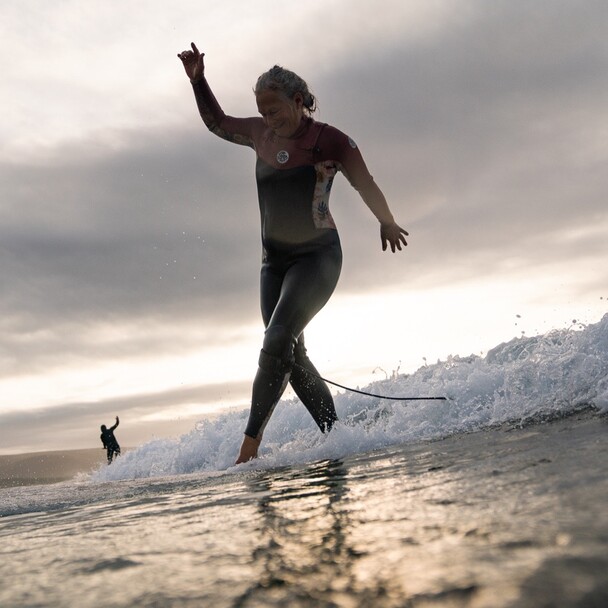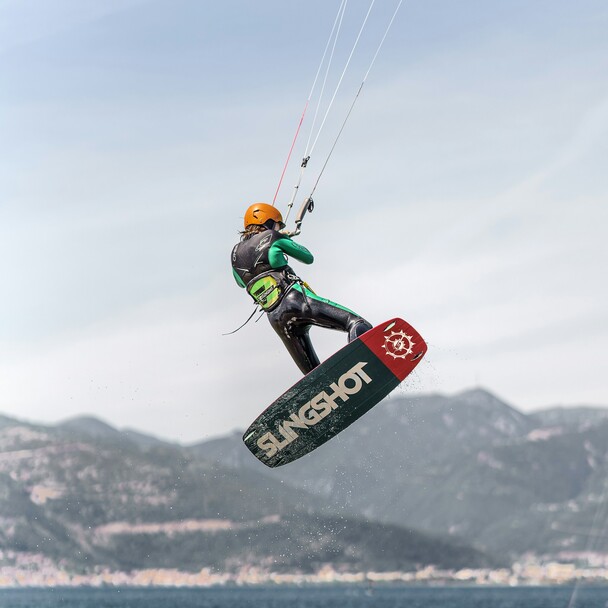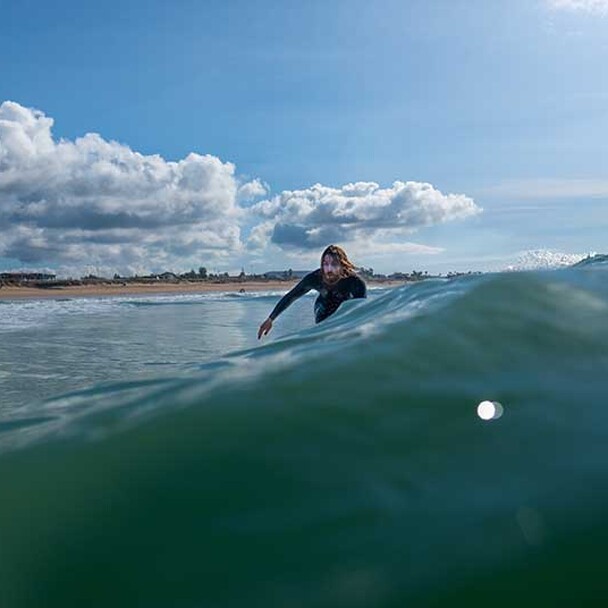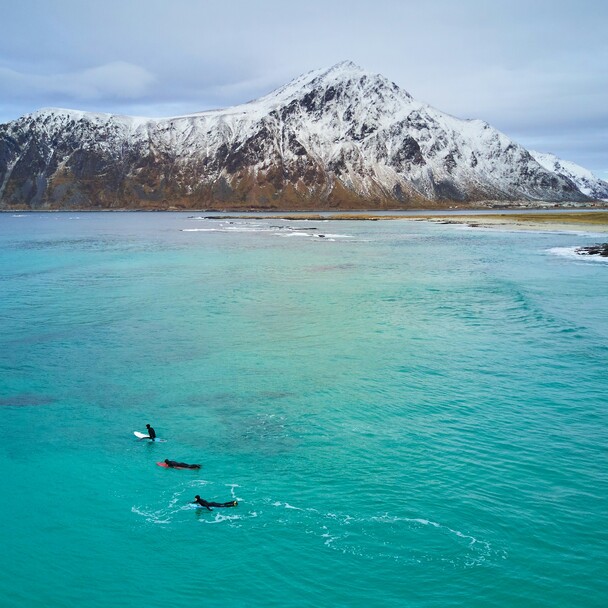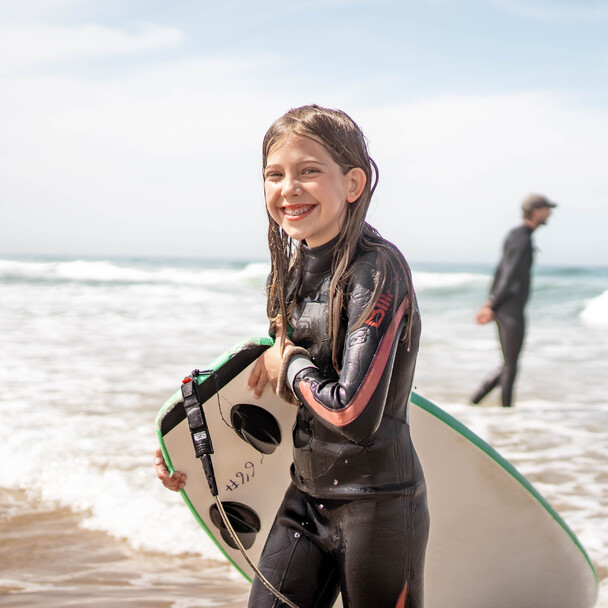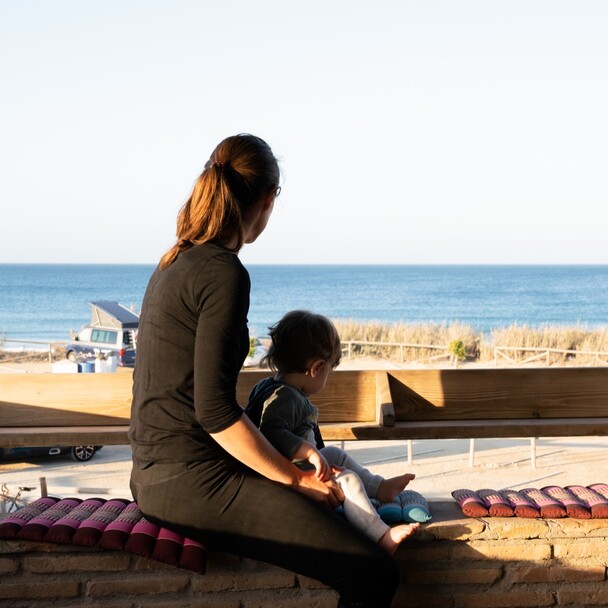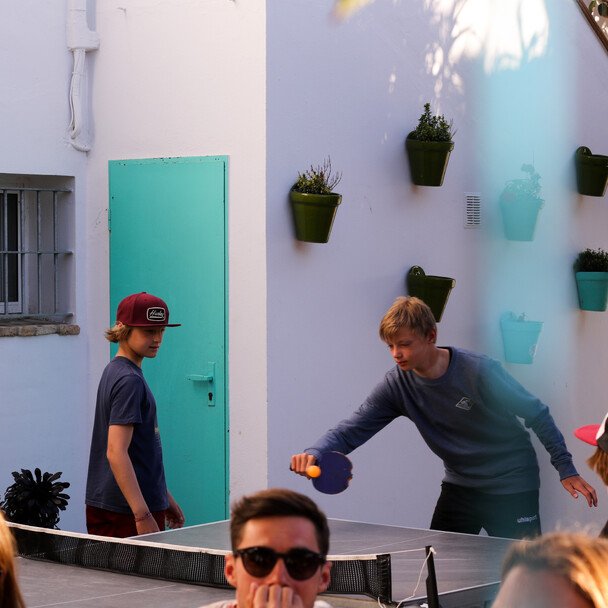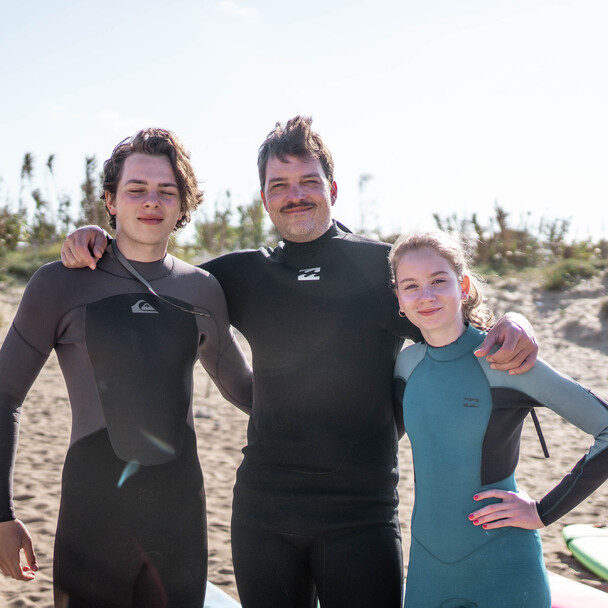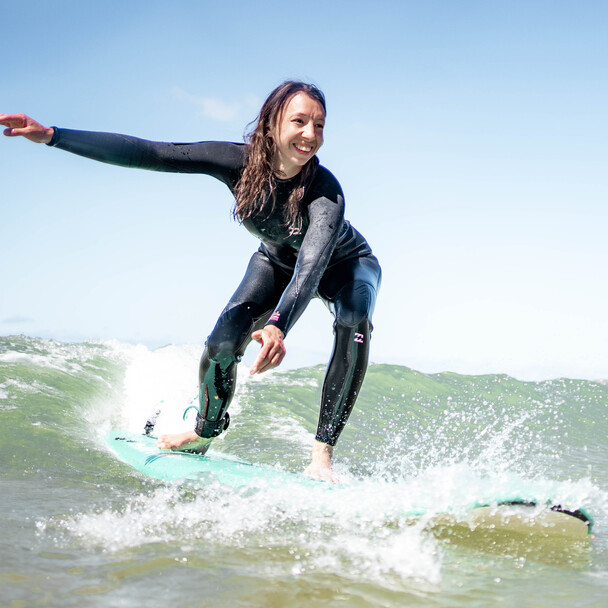Surfing - Everything you need to know
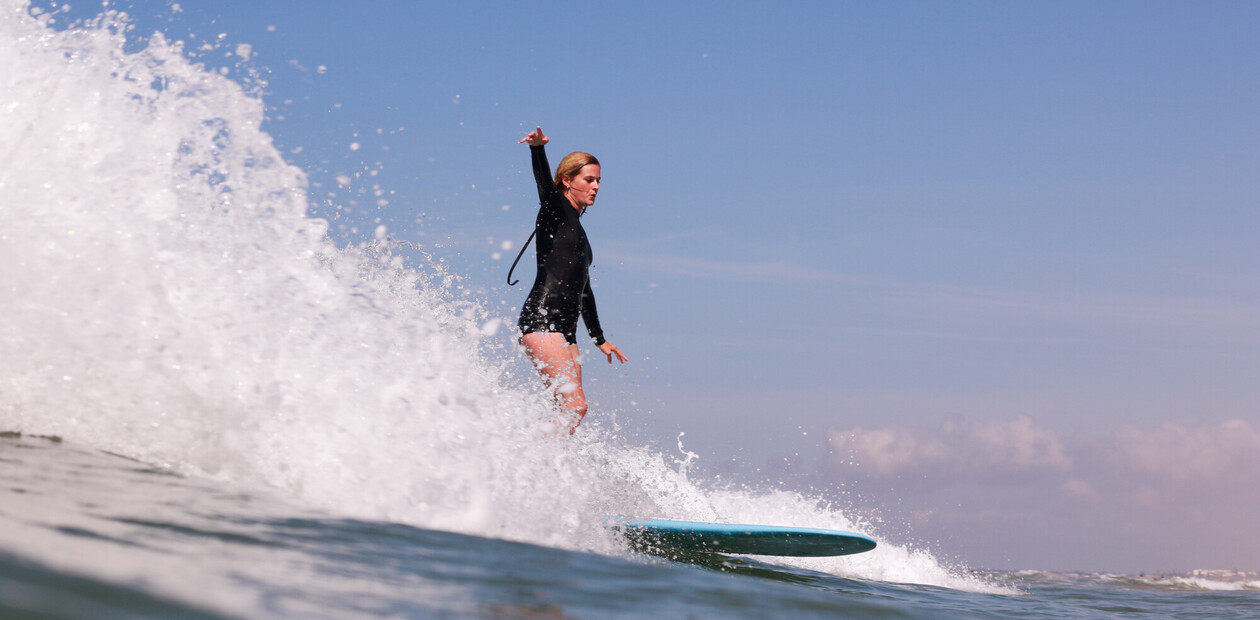
- What is surfing - these types of surfing exist
- Surfing
- Shortboarding
- Longboarding
- Big wave surfing
- Body surfing
- Bodyboarding
- Windsurfing
- Foil surfing
- Kitesurfing
- History of surfing
- Surfing has its origins in Polynesia
- Royal surfing in Hawaii
- Surfing was forbidden by the missionaries
- The beach boys of Hawaii
- Surfing became popular in the USA in the early 1900s
- Spread of surfing in Europe
- World Surf League & Competitions
- Surfing at the Olympics
- World record in surfing
- Where is the best place to surf?
- Surfing in Europe
- Surfing in Spain
- Surfing calendar El Palmar
- Surfing at the A-Frame Surf & Yoga Camp in Spain
- A-Frame Surf camp
- Surfing on the Canary Islands
- Surf spots on the Canary Islands
- Surfing in France
- Surf spots France
- Surfing in Portugal
- Surf spots Portugal
- Surfing in Madeira
- Surf spots Madeira
- Surfing in Denmark
- Surf spots Denmark
- Surfing in Germany
- Surf spots Germany
- Indoor surfing, standing waves & wave parks
- Other countries for surfing in Europe
- Surfing worldwide
- Surfing with the family
- Family surf camp at A-Frame
- How hard is it to surf?
- Can anyone surf?
- How healthy is surfing?
- Surf training - the right preparation
- What are the rules for surfing?
- Learn to surf
- Learn to surf for beginners
- Learn to surf with A-Frame
- What is the most important thing about surfing?
- Surf movies
- The best surf books
- Surf for yourself now!
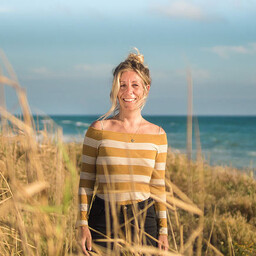
Jana is responsible for the website and blog at A-Frame. As a digital nomad and surf lover, she can work from anywhere in the world. She has currently opted for the Allgäu and El Palmar. For the Allgäu because of the love and for El Palmar because of the waves.
What is surfing - these types of surfing exist
There are different types of surfing. What we mean when we talk about surfing is so-called wave riding.
Surfing
Wave riding is a water sport in which a wave is ridden on a surfboard. This is a sober definition that doesn't really do surfing justice. Because surfing is much more than just a sport and riding waves. Surfing is courage, pure happiness, exhilaration, indescribable joy and a feeling of connection with the sea and nature. The famous quote from the surf movie "Point Break" sums it up perfectly:
"Surfing is the most beautiful experience you can have on this planet - a taste of heaven."
Today, surfing is an increasingly popular activity all over the world. With top international competitions such as the annual Quiksilver Pro Contest in Australia, surfing offers impressive opportunities to show off your talent - whether you're an experienced surfer or just want to have fun! But most surfers simply love the indescribably beautiful feeling of riding waves and surf for fun.
Shortboarding
For some, surfing with a shortboard is the real surfing. A shortboard is usually under seven feet (2.13 m) long and has a narrow nose. A shortboard is not suitable for beginners as it is not very stable due to the narrow nose and low volume. To surf a shortboard, you need a steep wave and a lightning-fast take-off. Such a short surfboard is made for making radical turns and other maneuvers. A dream for many, but it takes some practice to master such a board. So don't rush into it. :-)
If you're thinking about buying your own surfboard, take a look at our surfboard guide. Here you can find out what to look out for when buying a surfboard.
Longboarding
Longboarding is not just surfing on a longer board (at least 9'0 feet, i.e. 2.74 m). Longboarding is a very special form of surfing. In addition to the unmistakable style, the take-off and the surfing itself are also completely different. With a longboard, you can paddle into the wave much earlier than with a shortboard, for example, due to its volume and length, but it is not as easy to steer. You have more time for the take-off, the waves are generally smoother and slower and you can move forwards and backwards on the longboard. This is particularly popular with old school longboarding. The best known is the so-called "hang ten", where you stand at the very front of the longboard and dangle all your toes in the water. The new group of longboarders try to practice similarly radical maneuvers to shortboarding. Some also try to combine both styles.
If you would like to learn the technique of longboarding, we can highly recommend our Longboard & Yoga Retreat.
Big wave surfing
Big wave surfing is all about surfing big waves. It is not entirely clear when a wave is considered big. According to the Wave Culture Guide, big waves start at a height "of 15 to 18 feet and a face from 20 feet (approx. 6 m)". The surfboards are long and narrow and not designed for maneuvering. Big wave surfing is all about starting the wave and riding straight ahead as quickly as possible. As starting big waves is no longer possible with pure muscle power, the "tow-in" was invented. Surfers are pulled into the wave on a jet ski.
Known big wave surf spots worldwide:
Jaws, Hawaii
Maverick's, California
Cortes Banks, California
Nazaré, Portugal
Waimea, Hawaii
Belharra, France
Dungeons, Cape Town, South Africa
Outer Bommie, Australia
Pico Alto, Peru
Punta Galea, Spain
Ilha dos Lobos, Brazil
Body surfing
Body surfing is probably the oldest form of surfing. It does not involve using a surfboard, but simply your own body to glide along the wave.
Bodyboarding
In bodyboarding, the wave is ridden with a foam board. To be carried along by the wave, bodyboarders use short, hard fins on their feet.
Windsurfing
When windsurfing, the surfboard is also equipped with a sail. The sail can be turned and tilted, making impressive maneuvers and tricks possible.
Foil surfing
Hover over the water for once? No problem at all. Because that's exactly what foil surfing is all about. It usually involves combining a water sport such as windsurfing or kitesurfing with a foil board. Foilboards are surfboards that are equipped with a hydrofoil on the underside instead of a fin. This hydrofoil consists of the mast (centerboard) and 2 hydrofoils, which are connected by the fuselage. The faster you go in the water, the more water flows over the foil (buoyancy). It then continues to rise until the board is no longer in contact with the water. You are then virtually floating above the water. Foil pumping has also become very popular. This no longer requires a sail, or even waves or wind. You move the board with a certain technique using your own physical strength until you end up "floating".
Kitesurfing
When kitesurfing or kiteboarding, the surfer stands on a board that is more similar to a wakeboard than a surfboard. They are steered with a kite, a type of stunt kite.
History of surfing
The history of surfing dates back to ancient Hawaii, where the sport was first practiced by Hawaiian kings. Surfing then spread to other Polynesian cultures and finally took off in the early 20th century. Today, surfing is practiced by people all over the world and is considered one of the most popular outdoor activities. Find out more about the fascinating history of surfing here.
Surfing has its origins in Polynesia
Surfing has been part of marine culture for centuries. Its origins are attributed to the Polynesians. Polynesian cave paintings from the 12th century already show people gliding across the sea. People lived in harmony with the sea, men and women of all ages and status rode the waves with their bodies, a plank or a canoe. On one of their expeditions, the Polynesians finally brought surfing to Hawaii.
Royal surfing in Hawaii
For the Hawaiians, surfing even became part of their religion. From the construction of a surfboard to the first dip, religious rituals were performed to ensure the protection of the gods. Even the Hawaiian royal family loved surfing. The best boards and the best surf spots were reserved for them.
Surfing was forbidden by the missionaries
In 1778, Captain James Cook discovered Hawaiian surfers and was amazed. Almost 100 years later, Mark Twain and Jack London also reported surfing in Hawaii. Jack London even took surfing lessons. His "surf instructor", A.H. Ford, then opened the first surf club in the world, the "Waikiki Outrigger Canoe and Surfboard Club". With the arrival of the Christian missionaries in 1820, surfing was banned along with all other supposedly pagan customs. Surfing was only resumed at the end of the 19th century.
The beach boys of Hawaii
With the annexation of Hawaii to the USA in 1900, more and more tourists began to travel to Hawaii. So-called beach boys were to entertain hotel guests with their surf shows. Hawaiian lifeguards with surfboards were employed to ensure the safety of bathers. These employees were usually Hawaiian residents who had grown up with the sea and the local conditions.
The most famous beach boy and lifeguard was probably Duke Paoa Kahinu Mokoe Hulikohola Kahanamoku. He was simply known as "the Duke" and was one of the best surfers on the islands. He became famous for his Olympic victory in the 100 m freestyle in 1912. But wherever in the world he competed, he surfed the beaches and made surfing famous all over the world.
Surfing became popular in the USA in the early 1900s
When you think of surfing, the beaches of California immediately spring to mind. Surfing arrived here in 1907. In that year, the American highway owner Henry Huntington inaugurated his new railroad line. For a promotional stunt show, he invited Hawaiian surfer Georg Freeth to demonstrate his surfing skills on the beach. The surfing beach was later named after Henry Huntington Beach. The so-called Huntington Beach is still popular with surfers today.
Since this event, surfing has become increasingly popular with various groups: as a fashion trend in Hollywood, as inspiration for musicians and composers and as inspiration for beach culture. Surfing has become an integral part of beach communities across the country - from Malibu, California, to Montauk Point, Long Island. Since the early 1900s, surfing has been firmly rooted in American culture, and to this day it continues to captivate more people worldwide every day.
Spread of surfing in Europe
The first documented surfer in Europe was not just anyone, but none other than Edward Prince of Wales. Prince Edward took lessons from the famous Duke Kahanamoku during a stay in Waikiki in 1920, which immediately sparked his passion for surfing.
In 1923, the Englishman Nigel Oxendrew also took surfing lessons from the legendary Duke. He was also immediately hooked and founded the first surf club in Europe on Jersey, the "Island Surf Club". In the beginning, people surfed on their stomachs. However, it would be several years before surfing became popular.
It was not until the 1950s, when swimming became fashionable in England, that lifeguards equipped with wooden planks were deployed on the beaches. When the first Australians came to England as lifeguards and brought their new fiberglass surfboards with them, surfing became popular in England. In the 50s and 60s, surfing also became popular in France, northern Spain and Germany.
Source: Wave Culture - Fascination Surfing, 7th revised edition 2017
World Surf League & Competitions
There are now surf world championships and competitions all over the world. These are organized by the World Surf League (WSL). The WSL was founded in 1983 as the Association of Surfing Professionals (ASP).
The World Surf League is an association of professional surfers and helps to develop the ASP into a stronger, centralized institution. It oversees the major divisions of the World Championship Tours for men and women, the Qualifying Series (QS), the Big Wave Tour, the Big Wave Awards, the World Longboard Championships and the World Junior Championships. In addition to its headquarters in Santa Monica, California, the WSL has a business office in New York City and regional offices in Japan, Australia, France, South Africa, Brazil, Hawaii and Southern California.
You can find out more about the worldwide competitions on the World Surf League's website.
Surfing at the Olympics
Surfing is now even an Olympic sport. A vote was held in August 2016. All 90 IOC members voted unanimously in favor of surfing being included in the Summer Olympics in Tokyo. Surfing was included in the Olympic program for the first time in 2021. Surfing took place at Tsurigasaki Surfing Beach in Ichinomiya, around 65 kilometers outside Tokyo. Two surfing disciplines entered the race for Olympic medals:
Men's shortboard
Women's shortboard
The debut of surfing at the Olympics was a huge success and led to increased attention for the sport worldwide. Surfing will once again be part of the program at the 2024 Summer Olympics in Paris. The competitions are to take place on the beaches of Teahupo'o in Tahiti, French Polynesia, one of the most famous surfing spots in the world.
World record in surfing
The world record in big wave surfing was set in Nazaré, Portugal. German surfer Sebastian Steudtner surfed a 26.21-metre wave there in October 2020. "All the mountains have been climbed, all the deserts have been crossed. The only element that is still largely unexplored is water," Steudtner told the German Press Agency. "Being able to perform in this element makes me proud." Sebastian Steudtner has long been one of the best big wave surfers in the world. At the age of 16, he moved from Nuremberg to Hawaii to learn to surf properly.
In addition, Steudtner's record was officially recognized by the World Surf League and Guinness World Records in May 2022, further cementing his status as one of the leading big wave surfers. His passion and dedication have made him an icon in the sport of surfing.
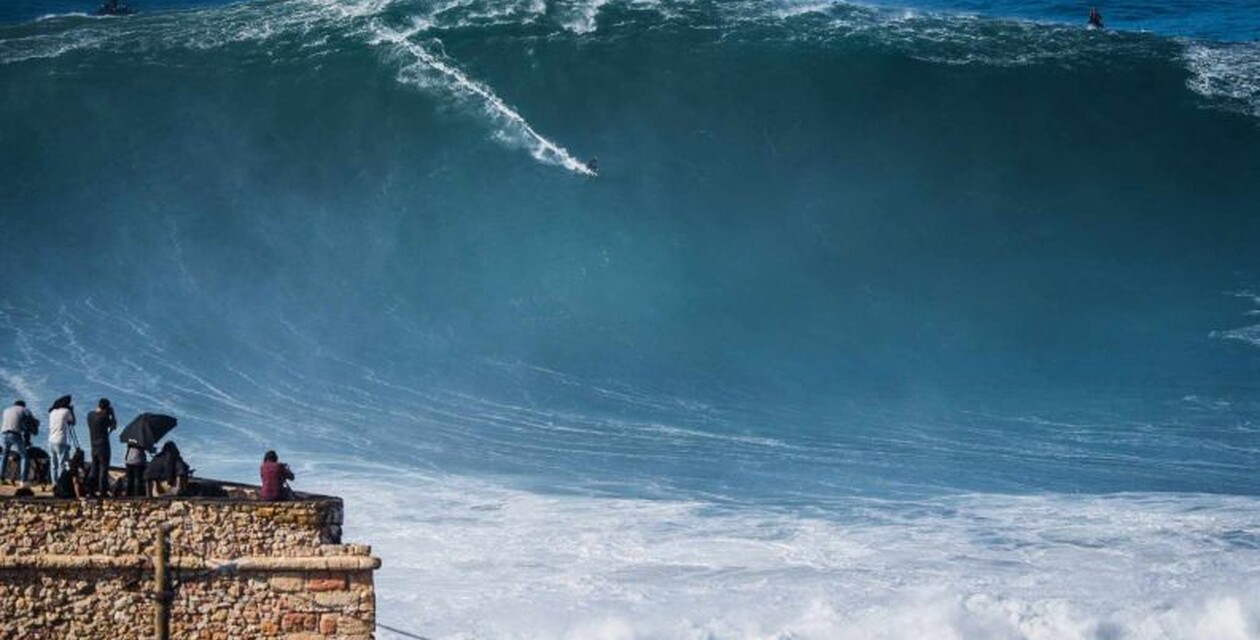
Where is the best place to surf?
The whole world is a gigantic wave playground for surfers. You really only have to choose one place. It's often not so easy to choose the right one from this huge selection. After all, everyone has different preferences and there are differences in terms of the quality of the waves, the water temperature and the time of year. Our A-Frame surf camp is located in Andalusia, in the south of Spain. For us, the perfect place to surf the beautiful waves. But there are of course many other places in the world that offer top waves for beginners and advanced surfers. Here is the best selection:
Surfing in Europe
Some people travel to faraway destinations such as Bali, Sri Lanka or Costa Rica to surf - especially in winter. We'll talk more about these countries later. But it doesn't always have to be a long-distance trip to surf good waves and enjoy warm weather. Europe also offers first-class waves for surfing or learning to surf. The entire Atlantic coast is blessed with wonderful waves all year round. And there are also surfable waves in the Mediterranean and the North Sea at certain times of the year. The advantage of Europe is the short journey, no jet lag and year-round wave safety. In southern Spain and the Canary Islands in particular, you can surf all year round in mild temperatures. It's also worth traveling here if you want to escape the cold winter for a few days.
Surfing in Spain
There are two coasts in Spain that are great for surfing. One is in the north and the other in the south of the country.
Northern Spain
You can surf in Spain all year round. Northern Spain is very popular in summer (July, August). This is because the weather can be warm at this time and, unlike the rest of Europe, it is not quite as crowded here. Popular surf spots in northern Spain are Zarautz and Oyambre/San Vincente.
Andalusia
From September to June, Andalusia, or more specifically El Palmar, is the place to go for surfing. Due to its geographical location, the climate here is like California, meaning it is sunny and warm all year round. Even in winter, you can enjoy your coffee in a T-shirt. Then there are the beautiful waves and the town's location right on the beach. No need to travel by car. Sounds too good to be true? But it is! :-) That's why we decided to open our A-Frame surf camp right here. 3,000 hours of sunshine a year and excellent waves on the doorstep are simply unbeatable.
A-Frame Surfcamp
Our surf camp is located right on the beach, so you can check out the waves at breakfast and enjoy the sunset at dinner. El Palmar has long since ceased to be an insider tip among Spaniards, but the relaxed surfing town is slowly becoming more popular with all other surfers in Europe. However, it is still not overcrowded here and you can always find a peak all to yourself. The 8 km long beach break also offers plenty of space.
There are other surf spots around El Palmar, for example for longboarders. Due to the different orientations of the beaches, there is almost always a surfable wave here.
Surf spots around El Palmar:
Playa El Palmar
Fuente de Gallo
Cabo Roche
Caños de Meca: Faro (longboard)
Caños de Meca: Marisucia
Caños de Meca: Apartamentos
Punta Paloma
Barbate
Best time to visit:
Once again, it can be summarized that northern Spain is particularly worthwhile in high summer, i.e. July, August. This is when you are most likely to have good weather. Of course, there are also good waves during the rest of the year, but it also rains a lot and can be quite cool. From September to June, southern Spain is the perfect choice. The weather is nice, the sun usually shines and the waves are consistent. In summer there can also be good waves here, but from fall to early summer the consistency is greatest. The area around El Palmar is perfect for a pinch of sun in the long German winter - and with a fairly short journey.
Surfing calendar El Palmar

Surfing at the A-Frame Surf & Yoga Camp in Spain
A surfing vacation at A-Frame means first-class surfing lessons, yoga by the sea, fantastic food with sea views, accommodation right on the beach and a warm team that will do everything to make your vacation unforgettable.
Our surf camp is located in the relaxed El Palmar, a coastal town near Cádiz. Everything here revolves around surfing. There are a few surf stores, restaurants and cafés. From September to June the atmosphere is very relaxed, in the height of summer it gets quite crowded, more and more bars open and the Spaniards celebrate summer and life. The waves are quite small at this time, which is why our surf camp is closed. Surf courses, especially for beginners, can still be booked through our surf camp.
Look forward to checking the waves at breakfast, fantastic sunsets over a 3-course dinner, an 8 km long beach break, our weekly BBQ, falling asleep to the sound of waves, sand between your toes, lots of sun and the salty Atlantic breeze in your nose.
Our guests are a colorful mix: single travelers, friends, couples, families, friends,... everyone is welcome.
We offer yoga retreats, surf yoga trips or a surf vacation with (or without) a surf course. Everyone can find their dream trip here. Meanwhile, we also always have specials such as a pottery & yoga, longboarding, Facial Reflexory Therapy in the program. Just browse through our varied packages. In any case, they all have one thing in common: a love of nature and the sea. And, of course, our A-frame quality.
A-Frame Surf camp

Surf course
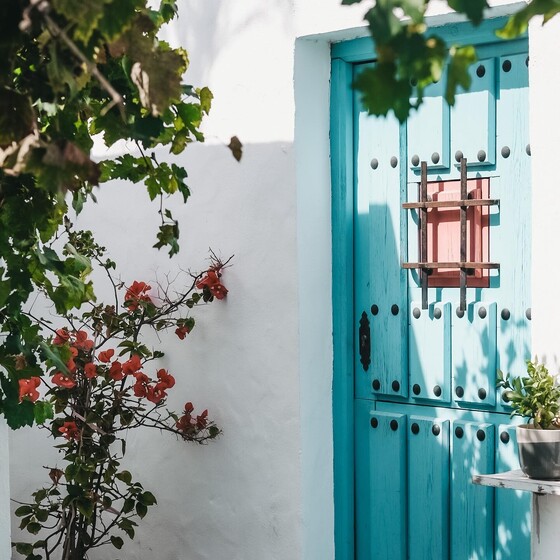
Camp
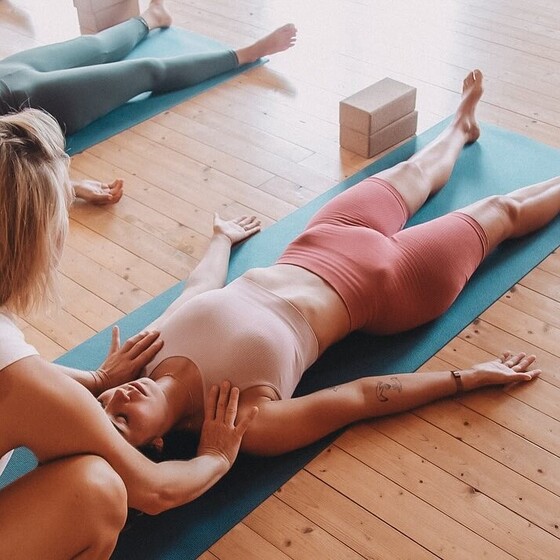
Yoga
Surfing on the Canary Islands
The Canary Islands are also part of Spain. Nevertheless, we have put them in a separate chapter due to their location on the northwest coast of Africa. Fuerteventura is probably the most popular island in the Canary Islands for surfing. It is also the second largest Canary Island. But Tenerife and Lanzarote are also great for surfing.
The Canary Islands are very popular for surfing, especially in winter. This is because the biggest waves can be found there at this time. The trade winds can sometimes blow, but otherwise it is quite mild here. It's not for nothing that the Canary Islands are a popular winter destination for pensioners ;) The Canary Islands owe their temperatures to their location on the African coast.
Surfing on Fuerteventura
The north shore is particularly suitable for surfing on Fuerteventura, as the reef conjures up beautiful waves here. The north shore begins in Corralejo and ends at the Cotillo lighthouse. The famous surf spots are right next to the approx. 20 km long gravel road. Many waves run over the reef here. But there are also beaches on the rest of the island where you can surf excellently. The beach breaks are certainly more relaxed for learning to surf, especially for beginners. To get to a surf spot, you sometimes have to drive down a gravel road past barren cliffs and lava rock. Getting there is often a bit of an adventure in itself.
Surfing on Lanzarote
Lanzarote is also a volcanic island. In terms of surfing, it is often overshadowed by the well-known Fuerteventura. But there are excellent surf spots here too. The landscape here is dominated by the red, brown and black tones of the lava landscapes. However, there are also white sandy beaches.
Surfing on Tenerife
In comparison to Lanzarote and Fuerteventura, Tenerife is not just made up of sandy earth tones and rugged volcanic landscapes. The evergreen mountains of Anaga spoil the eye with rich colors. Here you have to conquer the odd winding road by car to get to a surf spot, but there are waves all year round. Geographically, Tenerife is so cleverly located that swells constantly hit the island from all directions.
Best time to go surfing
You can surf on the Canary Islands all year round. However, most people are drawn to the islands in winter. This is when the waves are most consistent and biggest. In addition, in the winter months there is a particularly good chance that the piled-up waves will not be blown flat by the trade winds (especially on Fuerteventura). The Northshore works best with an easterly or southerly wind, which only occurs more regularly in the fall and winter, as the prevailing winds on Fuerteventura are predominantly from the north.
Surf spots on the Canary Islands

Surf spots on Fuerteventura
Flag Beach
El Cotillo
Playa Sotavento
Playa La Pared
Cofete
Bubbles
Los Lobos
Punta Blanca
Punta del Tigre
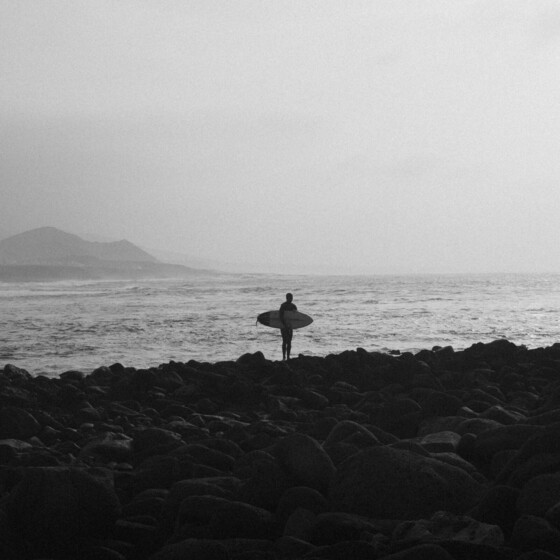
Surf spots on Lanzarote
El Pollon
La Santa
Golden Eye
San Juan
Arrieta
El Quemao
Caleta de Famara
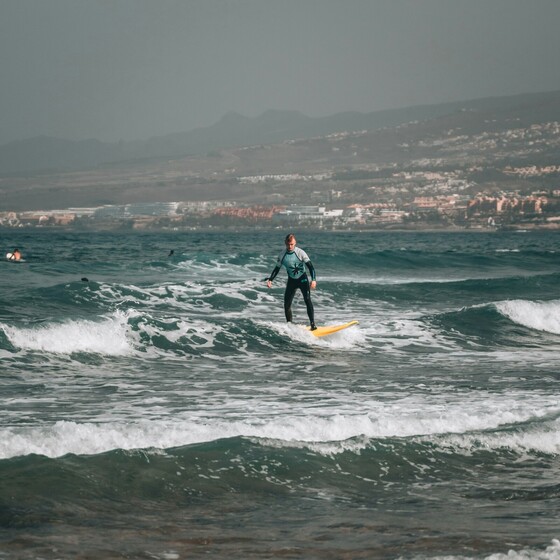
Surf spots on Tenerife
Igueste de San Andrés
Almáciga
Los Dos Hermanos
Bajamar
Los Patos
Playa Martianez
Surfing in France
Bonjours, welcome to France, the land of cheese, wine and waves. France's gigantic stretch of coastline on the Atlantic is famous among surfers. From rugged Brittany in the north to the Spanish border in the south, the waves roll onto the beaches and break over the sandbanks. A paradise for surfers. The choice of surf spots is indeed immense and we won't be able to list them all here. But that doesn't matter, because there are of course some classics that we won't withhold from you. And the rest are best discovered by yourself anyway.
Les Landes - from Lacanau-Océan via Hossegor to Biarritz
This stretch of the French coast is probably the most famous for surfing. When we think of Landes, we immediately smell the scent of pine forests. This is because most surf camps and campsites are located in the pine forests behind the dunes on the beach.
Younger surfers in particular appreciate the hustle and bustle and the affordable surf camps in this area of France. In summer, it can get hot here, the bars are filled with people and there is a real summer vibe. However, there are always relaxed spots to be found, as the coast is long. What's great is that you can usually walk from the campsite over the dune to the beach with a surfboard under your arm and the water can even be at boardshort temperature. At this time of year, there are also beginner-friendly summer waves that are ideal for surfing or learning to surf. A real paradise, especially for beginners. However, it can also get quite crowded in the water.
In the fall and spring, the waves get bigger and the wave quality and consistency increases. It is not without reason that the Quicksilver Pro World Championships take place in Hossegor every year in October. Pro surfers from all over the world flock here at this time of year. So if you're in the area in October, you should definitely stop by.
Brittany
In contrast to Hossegor and the surrounding area, surfing in Brittany is more relaxed. Many locals surf here, but they don't have the aggressive bite of the south; they surf mainly for fun and at any age. Here, too, you can often just walk from the campsite to the beach. The beaches are framed by scenic bays and cliffs. Brittany's appeal lies less in its sunny side and more in its many bays with different orientations, so you can find a surfable wave in all wind conditions. And apart from the waves, the Breton culture and architecture are of course also worth a visit.
Best time to visit
Les Landes: Summer, from June to September, is the best time for surfing. The weather is warm, the water is warm and the waves are not too big. This time is ideal for beginners, but also for advanced surfers. The bars and campsites also fill up at this time, so there is plenty going on. If you prefer a relaxed vacation away from the hustle and bustle, you should pay attention to the choice of location. Or choose a different destination for the summer. In winter, the waves become more consistent and bigger, but then the weather is no longer nice and it can get very stormy.
Brittany: Brittany is not exactly famous for its sunny weather. Similar to northern Spain, the climate is harsh and you should plan your surfing vacation for the summer. Families with children and beginners in particular will enjoy the small waves and Caribbean blue water. Larger waves can be found here in fall, winter and spring (although only locals can actually be found in the rather cold water in winter).
Surf spots France

Surfspots Les Landes
Carcans Plage
Lacanau-Océan (Hausstrand von Bordeaux)
Biscarrosse Plage
Mimizan Plage
Moliets Plage
Vieux Boucau
St. Giron Plage
Hossegor
Grande Plage, Biarritz
Cote de Basques
Lafitenia
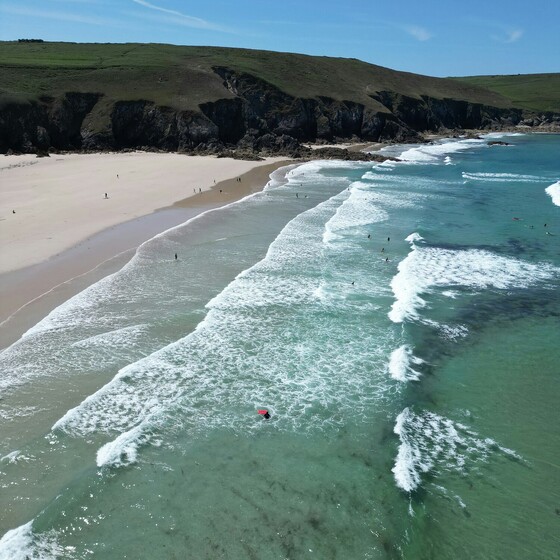
Surf spots Brittany
Cap Frehel (North Finisterè)
Pors ar Villiec (North Finisterè)
Le Dossen (North Finisterè)
Anse de Pen Hat (Crozon Peninsula)
Goulien (Crozon Peninsula)
Pointe de Dinan (Crozon Peninsula)
La Palue (Crozon Peninsula)
Plage du Ris (Crozon Peninsula)
Baie des Trépassés (Crozon Peninsula)
Saint Tugen (Crozon Peninsula)
Pointe de Lervily (Crozon Peninsula)
Gwendrez (Crozon Peninsula)
Penhors (Crozon Peninsula)
La Torche (the most popular beach break in Brittany)
QuiberonPeninsula
Surfing in Portugal
Surfing in Portugal is very popular with most surfers in Europe. No wonder, as Portugal offers a long coastline with numerous surf spots. From the north near Viano do Castelo to Porto, Peniche, Ericeira, Lisbon and down to the Algarve, the coast offers countless beaches for wave-hungry surfers. Especially in the south, the climate is quite mild even in winter and waves almost always roll onto the coast. They can get quite big, but thanks to the many bays and the different orientations of the coast, there is usually a surf spot with smaller waves or white water for practicing. You are never alone in the water here, but the popularity has its price. But the Portuguese hospitality and good cuisine make up for it.
Best time to travel
The best time to travel to surf in Portugal is from April to October. During these months, the waves are consistently good and the weather is pleasantly warm. For experienced surfers who prefer bigger waves, the winter months from November to March are ideal, as the biggest swells hit the coast during this time.
Surf spots Portugal
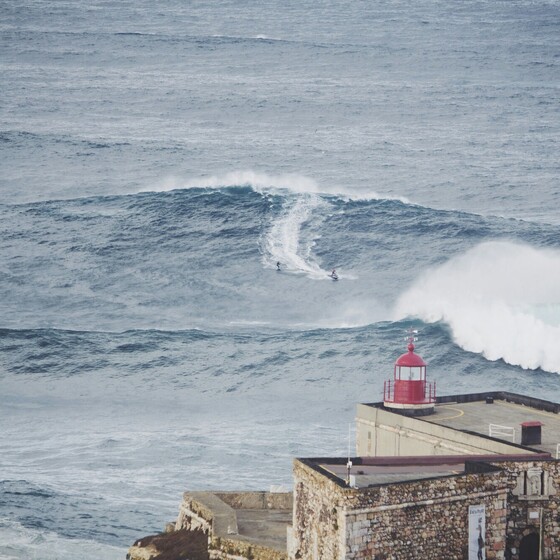
Surf spots in northern Portugal
Moledo
Afife
Praia do Cabedelo
Esposende
Matosinhos
Espinho
Barra
Costa Nova
Praia da Tocha
Buarcos
Cabedelo
São Pedro de Moel
Praia do Norte (Nazaré)
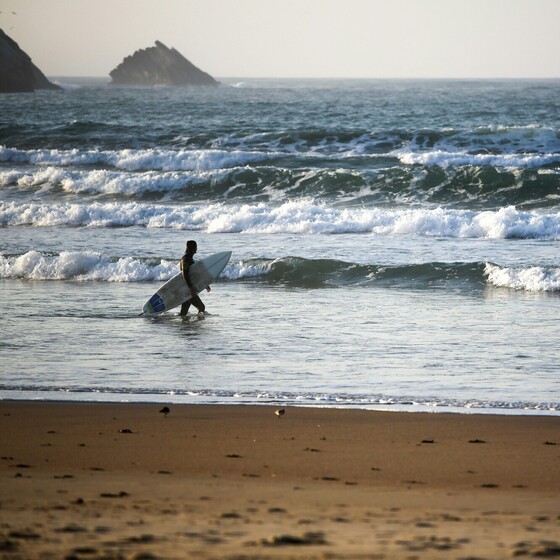
Surf spots in central Portugal
Ferrel (Peniche)
Lagide (Peniche)
Prainha (Peniche)
Baleal (Peniche)
Molhe Leste (Peniche)
Subertubos (Peniche)
Consolação (Peniche)
Santa Cruz
Coxos
Ribeira d'Ilhas (Ericeira)
Praia do Norte (Ericeira)
Foz do Lizandro (Ericeira)
Praia das Maçãs
Praia Grande
Guincho
Carcavelos (Lisbon)
Costa Caparica (Lisbon)
Fonte de Telha (Lisbon)

Surf spots in the Algarve
Odeceixe
Amoreira
Monte Clerigo
Arrifana
Bordeira
Amado
Cordoama Castelejo
Beliche
Tonel
Mareta
Ingrina
Zavial
Salema
Burgau
Luz
Meia Praia
Surfing in Madeira
Madeira belongs to Portugal and is part of an archipelago of islands. The so-called island of eternal spring is ideal for surfing. Advanced surfers in particular can look forward to reef and point breaks. The waves are best in winter, although generally not as consistent as on the Portuguese mainland. Temperatures are mild and sunny all year round, especially in the south. As well as surfing, there is fantastic hiking here. There are hardly any sandy beaches here, most of the waves break over reefs. You should be aware of this. The most famous wave on the island is Jardim do Mar, but it has been partially destroyed. Nearby is the surf spot Ponta Pequena.
Best time to visit
The best time to visit Madeira for surfing is from October to March. During these months, the waves are the most consistent and ideal for experienced surfers. For those who also want to enjoy other activities such as hiking, the period from April to September is ideal, when the weather is particularly pleasant and temperatures are mild.
Surf spots Madeira
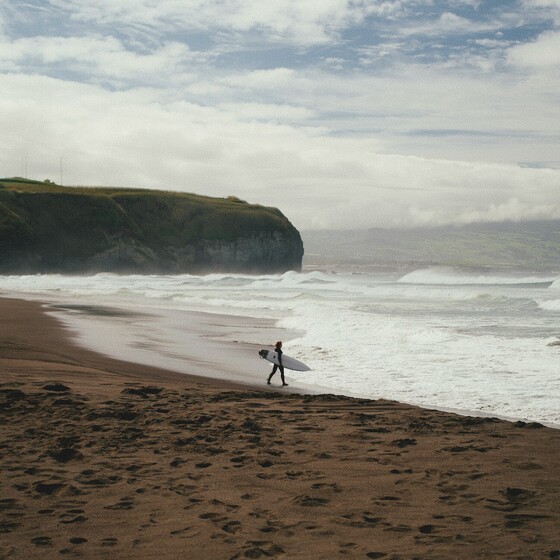
Madeira
Paul do Mar
Sao Vicente
Faja da Areia
Porto da Cruz (beginner)
Machico
Surfing in Denmark
For anyone who doesn't mind cold water, Denmark is a great option. Surfers from northern Germany in particular often travel to neighboring Denmark to surf in the North Sea. The journey is not far, so a surf trip is also possible on a weekend. The wave quality is generally not comparable to that of the Atlantic, as wind swell waves are usually surfed here. These can sometimes be a wild mess. However, there are also decent groundswells from the northwest, especially on the coastal section from Klitmøller to Agger.
Cold Hawaii
The so-called Cold Hawaii is therefore a good alternative if you don't want to travel that far. The atmosphere is actually quite relaxed, and on windy days there are also many windsurfers and kitesurfers. It's best to rent a vacation cottage or a pitch at Nystrup Camping (Klitmøller).
Best time to visit
The weather in Denmark is naturally at its best in summer. However, this is not actually the best time for surfing. Nevertheless, some good swells can also arrive in Denmark in summer. The best thing to do is check the surf forecast. The best time for surfing with the most consistent swell is fall and winter. At this time, the water is really cold, so a thick wetsuit, hood, booties and gloves are part of the basic equipment. The best compromise between weather and waves is September and especially October. Then the waves are already quite consistent and the weather is not yet icy.
Surf spots Denmark
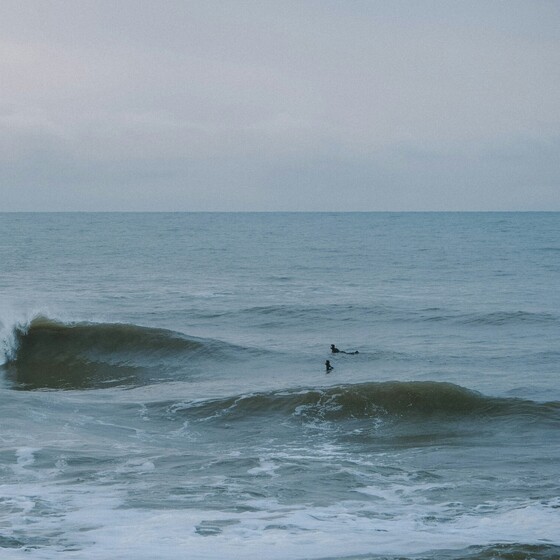
Surfspots Denmark
Hanstholm
Klitmøller
Nørre Vorupør
Agger
Hivde Sande
Surfing in Germany
Yes, you can even surf in Germany. The possibilities are actually quite varied. Similar to Denmark, the swell here is limited to wind swell in the North Sea and the Baltic Sea. But there are also river waves and so-called wave parks or indoor waves.
Surfing on Sylt and the North Sea
On the North Sea, the island of Sylt and St. Peter-Ording are the surf spots par excellence. A real surf scene has developed here, and people from Hamburg are quick to travel to the North Sea to ride a few waves because of the short journey. St. Peter-Ording is easier to get to, while Sylt has a few more surf spots, including a longboard spot. There are always some decent waves here - but the conditions have to be right, and that doesn't happen very often. As the water in the North Sea is quite cold, you should equip yourself accordingly. Even in summer you need a 4/3 wetsuit, in fall and winter a 7/6, hood, booties, gloves or even a fullsuit. In the fall, a 5/3, hood and booties may be enough.
Surfing in the Baltic Sea
To surf in the Baltic Sea, you have to keep a very close eye on the wind conditions and strike at the right time. There is simply not enough water to develop sufficient swell. So the opportunities are few and far between and the windows of opportunity are short. But they do exist. Here you need the same warm neoprene equipment as on the North Sea. In other words: a 7/6 fullsuit or hood, booties and gloves in winter. A little less in spring and summer, but nothing less than 4/3 is really possible here.
Best time to go
The best time to go surfing on Sylt and the North Sea is from September to April, when the waves are at their most consistent. Summer can also offer good days, but the conditions are less predictable.
The best time to go surfing in the Baltic Sea is from October to April. During these months, the chances are higher that the wind conditions will generate sufficient swell. In summer, there may also be occasional surfable days, but these are rare and difficult to predict.
Surf spots Germany

Surf spots on the North Sea
Januskopf (Norderney)
Brandenburger Strand (Sylt, most famous spot)
Kartoffelkiste Wenningstedt (Sylt, big wave spot)
Stormcap in Kampen (Sylt)
Buhne 16 Kampen (Sylt, Longboard)
Ellenbogen-Spitze (Sylt, for advanced surfers)
K4 (Sylt, good for beginners at low tide)
St. Peter-Ording (Ordinger Strand approach)
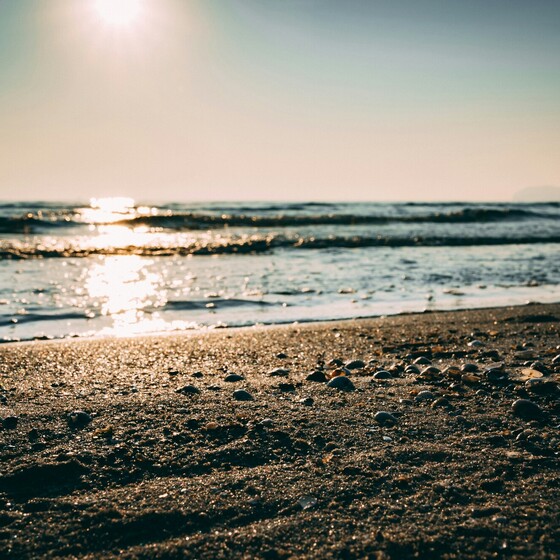
Surf spots on the Baltic Sea
Timmendorfer Strand
Damp 2000
Kühlungsborn
Wustrow
Warnemünde
Fährwelle Warnemünde
Binz (best-known spot on Rügen, there is a surf foercast at Magicseaweed)
Rügen Island in general
Indoor surfing, standing waves & wave parks
When you think of surfing in Germany, you probably first think of the sea - of course. That means surfing on the North Sea or the Baltic Sea. But we've already mentioned it above: for all landlocked surfers who don't have the sea around the corner, there are now good alternatives for surfing a few waves now and again without the sea. Wave parks and indoor surf waves are all the rage at the moment. There are now opportunities to surf such waves all over Germany.
Best time to go surfing in Germany
If you like, you can surf in Germany all year round. On the North Sea and Baltic Sea, winter offers the most waves, while spring is usually best on the river waves. This is when it rains the most and the water provides the best pressure. Outdoor artificial waves are most frequently visited in summer, while an indoor wave park can of course be visited all year round.
The best-known artificial waves are:
Indoor surfing: Wellenwerk Berlin
Indoor surfing: Citywave Hasewelle, Osnabrück
Wavepark: Lakesurf Langenfeld
Planned for 2024: Surfgarten Stade (Hamburg)
Indoor surfing: Citywave Jochen Schweizer Arena, Munich
Standing river waves: Eisbach Munich, Floßlände Thalkirchen
Surfing in Berlin - indoor surfing at Wellenwerk
In Berlin, there is the famous Wellenwerk. An indoor surf wave with a pleasant 26 °C water temperature is artificially created here. There are surf courses for all ages, surf camps and much more. Thanks to the individual wave height, indoor surfing is suitable for all levels. So you can satisfy your longing for surfing all year round.
Surfing in Osnabrück: indoor surfing at L&T Citywave Hasewelle
Adults and children from the age of 8 can surf or learn to surf on the Hasewelle. There are beginner courses, courses for advanced surfers and slots for pros. The L&T also organizes kids camps, teen camps & contests. The water temperature is 20 °C.
Surfing in Langenfeld - Wavepark on the lake
The first standing wave on a lake is located in Langenfeld (between Cologne and Düsseldorf). For all landlocked surfers, this is a great way to stay in shape. The wave is adjustable in height, so there are various offers such as medium surf sessions, big surf sessions, pro sessions, beginner courses and much more. You can also rent the wave exclusively for yourself or a group.
Surf garden in Stade - opening planned for 2024/25
The concept of the surf garden is based on the so-called Cove technology from the Spanish manufacturer and system supplier "Wavegarden". They are considered a pioneer and market leader in the construction of surfing facilities. In addition to surf courses and slots for free surfing, the all-round experience is planned: adventure playground, surf lodges, camping meadow, sun deck, restaurant & café and much more. Sustainability and climate protection are important to the operators. That's why the electricity is sourced from 100% renewable sources and supported by their own photovoltaic systems.
o2 Surftown MUC
The o2 Surftown MUC in Munich is an innovative surf park based on state-of-the-art wave technology and supported by Endless Surf® technology. This makes it possible to create waves of different heights, lengths and intensities, providing ideal conditions for beginners and experienced surfers alike.
The surf park offers four different surf zones: A-frame mode for intermediate to advanced surfers, pointbreak right and left for longer waves and special beginner zones with safe, flat waves for those first surfing experiences. All surf sessions are professionally supervised by surf coaches and lifeguards to ensure maximum safety.
Surfing in Munich - Wavepark & Flusswellen
Jochen Schweizer Arena Munich
Similar to Berlin and Osnabrück, there are various offers for beginners, advanced surfers, children and private groups. The surfing time is perhaps a little short at 45 minutes and 12 participants, but the waves are probably very nice.
Surfing on the Eisbach
The most famous river wave in the world is the Eisbach wave in Munich. People sometimes surf here around the clock. The queue can get quite long and there are always quite a few spectators. The Eisbachwelle is less suitable for beginners.
Surfing in Thalkirchen
An alternative to the Eisbachwelle can be the Floßlände in Munich Thalkirchen. There is usually less going on here.

Other countries for surfing in Europe
England (Cornwall, e.g. Bedruthan Steps, Porthcurno, Sennen Cove, Gwithian, Watergate Bay, Fistral Beach, Porthtowan)
Wales (Llangennith Beach, Freshwater West Beach, Llantwit Major Beach)
Ireland (Bundoran, Lahinch, Strandhill, Inch, Tramore)
Holland (Zandvoort, Texel Island, Scheveningen)
Norway (Lofoten, Jæren, Stad: Ervikstranda & Hoddevik)
Italy (Capo Mannu & Cala Domestica in Sardinia in the fall, Levanto, Varazze & Lerici in Liguria) > Not very consistent as Mediterranean, but possible from time to time
Surfing worldwide
If you're drawn to faraway places, you'll soon realize it: You can surf anywhere in the world and just have to decide. Whether Australia, Oceania, the USA, Canada, Asia, Africa, Central America or South America - there are countries with excellent surf spots everywhere. To list them all would go beyond the scope of this article. That's why we list the most important and best-known countries for surfing.
USA: California, Hawaii
Canada: Vancouver Island
Central America: Costa Rica, Nicaragua, Panama, El Salvador, Mexico
South America: Peru, Brazil
Australia
New Zealand
Asia: Sri Lanka, Indonesia, Philippines
Africa: Morocco, South Africa, Namibia
Surfing with the family
A surf camp is definitely the most relaxed choice for a family surfing vacation. This is because a surf camp usually offers surf courses for children and parents, childcare and the food is prepared for you. This means that parents also have a real vacation and can let themselves be pampered. After all, a surfing vacation should be for the whole family.
Family surf camp at A-Frame
At A-Frame, we focus on families all year round. But several times a year we offer special family weeks, during which we dedicate even more time to families than we already do. During this time, there are plenty of playmates for the kids and the surf courses are offered for children from the age of 8.
Surf camp with childcare
Since surfing with small children often means that only one parent can be in the water at a time, we at A-Frame offer childcare during the surf courses. This makes a surf camp vacation with a small child a very special experience. Parents have quality time in the water, there is also yoga (if one of them is not surfing), massages and excellent food. We want the whole family to be able to relax and the surf vacation to be a very special experience for you as a family. Accordingly, our accommodation offers the necessary privacy, a fully equipped kitchen and a washing machine. The location right on the beach is of course unbeatable with children.
How hard is it to surf?
Almost anyone who is reasonably physically fit can learn to surf. Depending on what your goal is, different levels of fitness are an advantage. Do you just want to surf a few small green waves from time to time or do you have your eye on shortboarding and fast maneuvers? Of course, one is faster than the other. In any case, body tension, a sense of balance and plenty of practice and routine are important. But the most important thing is to have fun in the water. The great thing about surfing is that it's fun right from the start. Even gliding on your belly in white water can be fun and the first successful stand up triggers a veritable whirlwind of endorphins. The smile on your face will never disappear. By the time you surf your first green wave, most people are hooked ;)
Can anyone surf?
We've basically just answered that: Yes! Depending on your physical fitness, you may have to cut back. But surfing starts with practising gliding in white water. And anyone can do that. Incidentally, we have guests of all ages at the surf camp. From children to grandparents, we've had all age groups on our surf courses. And they all had fun. :)
How healthy is surfing?
If you surf regularly, it's a great way to improve your flexibility and stamina. Because surfing works the whole body. After all, surfing is not just standing on a surfboard. Surfing means paddling, body tension, take-off, keeping your balance and so on. You use your bones, tendons and most muscle groups. If you want to know exactly:
Paddling: Triceps, biceps, deltoids; trapezius muscle, rectus abdominis muscle, latissimus dorsi muscle and m. Obliques
Take-off: Pectoralis major, Deltoideus, Triceps
Pop-up: Quadriceps, Gluteals and Gastrocnemius
Balance: Torso Rotations
You see, surfing is very healthy for the whole body. Combine it with some yoga and the harmony is perfect. You can find the best surf yoga exercises in our blog. Or how about a surf yoga trip in Andalusia?
Surf training - the right preparation
Surfing is great fun and keeps your body in shape. So that you can enjoy surfing even more, the right training between your surfing vacations or surf sessions is crucial. You can also prepare for surfing at home with the right surf fitness exercises. We will go into the following. Just click on the links and you'll be taken to the relevant article:
Surf Fitness (six to eight weeks before your surf vacation)
What are the rules for surfing?
To ensure a relaxed atmosphere in the water, respect for other surfers is the most important rule. But how exactly do you show this respect? There are unwritten rules in surfing that surfers around the world abide by (unfortunately not all of them, but there are always black sheep). These include right of way rules, rules when paddling into a wave and when paddling out into the line-up. In the blog post on the most important surfing rules, we have written everything down. Basically, it's all about not getting in anyone's way and not snatching "their" wave.
When should you go surfing?
It's best to only go surfing when the conditions at the surf spot are such that you feel up to the situation. Both physically and mentally. Overconfidence is actually dangerous and can lead to accidents. So take a close look at whether the waves suit you. Also check beforehand whether there are currents at the spot and, if so, how and where they run. In our Surf Spot Check, we go into more detail about what you can do before you go surfing. Safety first.
What can happen while surfing?
Is surfing dangerous? This question is often asked. But surfing is not as dangerous as some might think. If you follow a few rules and take certain safety precautions, the risk can be reduced to a minimum. Many surfers are of the opinion that other surfers are the biggest source of danger. Keyword: increasingly crowded line-ups. According to Surfers Mag, however, it is the surfer's own surfboard that leads to the most frequent surfing injuries (40%). Followed by injuries caused by the seabed (reef, rocks) and maneuvers. Accidents caused by others probably only account for 6%. (Source: Surfersmag)
Here's what you can do to minimize the risk when surfing:
Surf spot check before surfing
Listen to your inner voice: Are you physically and mentally fit today?
A warm-up reduces the risk of injury.
Californian emergency physician and surfer Andrew Nathanson recommends using rounded fins without a sharp edge, boardshapes with a rounded nose and a sufficiently long leash. (Source: Surfersmag)
When falling off the surfboard: Protect your head with your arms and hands.
Never carry the surfboard between you and the waves. This will ensure that the board doesn't hit you in the face with the next wave or the wind.
Keep a sufficient distance from other surfers
Always attach and detach the leash on the beach. Not in the water.
Practice diving techniques or turtle roll instead of simply "throwing away" your surfboard.
On rocky ground or reef: wear booties and get off your surfboard in good time (before the water is too shallow)
In shark areas: Heed warnings and flags. However, shark accidents are quite rare. Fatal bicycle accidents or mosquito bites are more common. According to Statista, "a total of 57 shark attacks on humans were recorded worldwide in 2022. Of these, five shark attacks were fatal. {...} Most shark attacks recently took place in the USA and Australia."
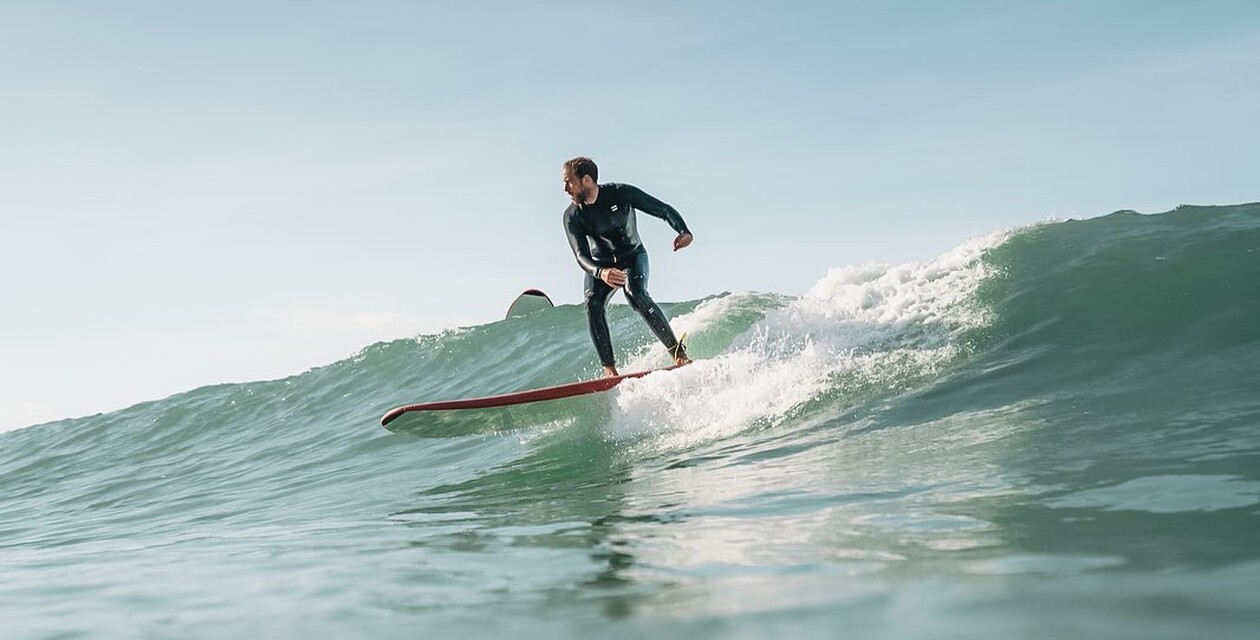
Learn to surf
Learning to surf properly can take a while, but it's great fun right from the start! Just practising gliding in the water, the first success when standing up and finally surfing a green wave - everything gives you feelings of happiness and a beaming smile on your face right from the start. The best way to learn to surf is to take a surf course. Because then the wrong habits don't creep in. It can also be a little tricky at first to find the right position on the surfboard and to read the waves correctly. It's best to have an experienced surf instructor and a few like-minded people with you.
Learn to surf for beginners
If you don't want to wait until your next surf course, you can find out more in our guide to learning to surf for beginners. In it, we not only reveal the best exercises for beginners, but also answer questions about safety, age, fitness, warm-up and much more.
Learn to surf with A-Frame
We offer surf courses for all levels at our surf camp and surf school. Whether families, friends or individuals, we will find the right surf course for you. When learning to surf, we attach great importance to excellent surf instructors, small groups and optimal surfing conditions for the respective level. This is because we believe that quality and individual attention in the courses provide the best surfing experience. Surf students should be able to get the best out of themselves and still have fun. Wetsuits and surfboards are of course included in the surf course.
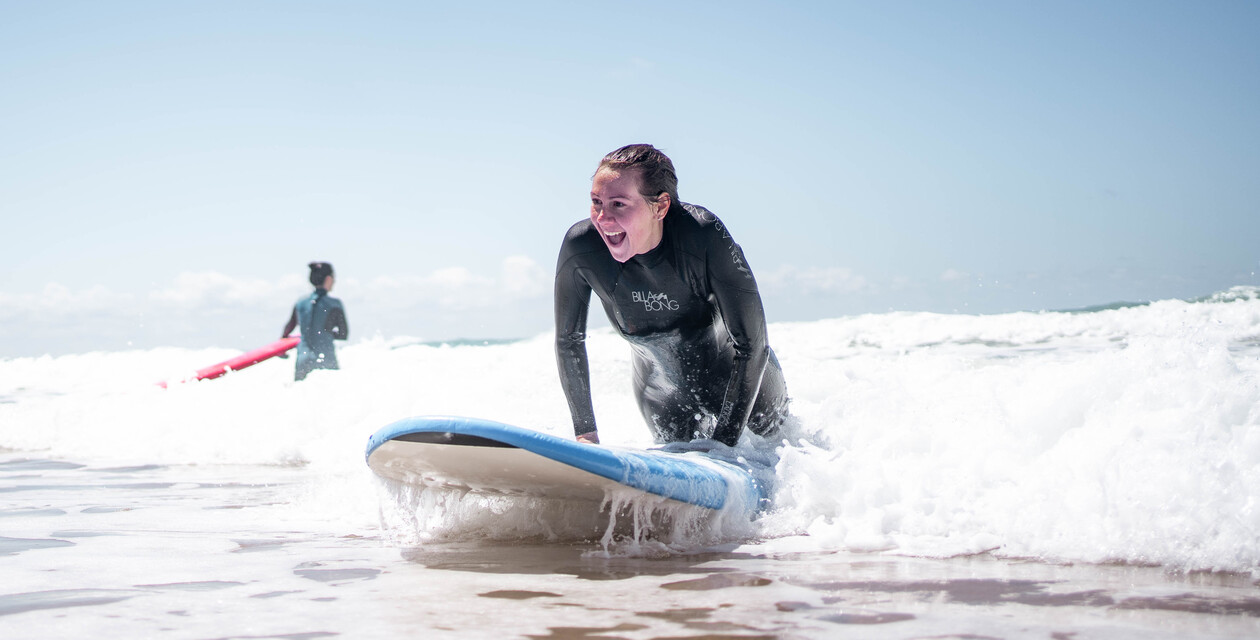
What is the most important thing about surfing?
The most important thing about surfing is, of course, having fun. But we also have other tips on what to look out for when surfing.
The right equipment: Choose the right surf clothing and the right surfboard depending on the surfing area.
Choosing the right surf spot: If you're going into the water alone, check the surf spot thoroughly beforehand. Are there currents, how big are the waves, etc.? We have put together a guide to the surf spot check. In any case, only go into the water if you feel comfortable and the conditions suit your ability.
Read the surf forecast: When are the conditions at which surf spot? Reading a surf forecast is extremely useful for checking conditions such as wave size, strength, wind, etc. We explain how to read a surf forecast in our detailed blog: Reading the surf forecast - here's how.
Warm-up: Warming up reduces the risk of injury, increases your performance and prepares you physically and mentally for the upcoming movements.
Material check: Before surfing, be sure to check whether the material is still in good condition. Are the fins tight, is the leash still intact, does the wetsuit have holes, etc.
Right of way rules & surf etiquette: Familiarize yourself with the surf rules. We explain these in detail in the guide to the most important surfing rules.
Practice diving through the waves: Whether duck dive or turtle roll: diving through a wave makes it easier to paddle out. In addition, the surfboard should not simply be thrown away, otherwise another surfer could be hit.
Surf training: Surf Fitness keeps you fit between surf trips and prepares you perfectly for surfing.
What do you need to surf?
You don't actually need much to surf. That's one of the great things about surfing. No complicated equipment that takes a long time to prepare. This is the equipment you need for surfing:
Surfboard + fins + leash
Neoprene wetsuit or Lycra
if necessary. Booties, gloves, hood
Wax or pad
Noseguard
Board bag
Sun cream (waterproof, 50 SPF) / zinc - even on cloudy days
Surfboard
All you really need is your surfboard and a wetsuit or lycra, depending on the surfing area. The surfboard should be equipped with fins and a leash. The leash should be as long as the surfboard (or slightly longer). This is because in the event of a fall, the board is far enough away from you to prevent you from being injured.
As far as the surfboard itself is concerned, there are now different types for every condition and skill level. As a rule, the dimensions are given in feet. One foot corresponds to 30.48 cm. These are the different types of surfboard:
Fish: Shorter and wider than a shortboard, approx. 6 feet long, good for first experiences with short boards, ideal for small to medium-sized waves and onshore winds; popular for news school tricks
Shortboard: Max. 7 feet, pointed nose, 3 fins, for experienced surfers, intended for radical turns and tricks
Funboard: Approx. 7 feet, halfway between minimalibu and shortboard, forgiving, early planing, good for advanced surfers
Gun: Ideal for big fast waves, at least 7 feet and narrow
Malibu & Minimalibu: 7-9 feet long, similar shape to longboard. Forgiving, ideal for beginners and small waves (or North Sea swell)
Longboard: from 9 feet, lots of lift due to round nose. However, not beginner-friendly due to the handling
If you want to know what you should look out for when buying a surfboard, we have put together a guide to buying a surfboard. In it, you can also find out everything about the shapes and which board is suitable for whom: Buy a surfboard blog
If you want to find out more about the design and construction of a surfboard, our Surfboard Design guide is sure to be interesting for you.
Wax or wax
For a good grip on the board, it is waxed beforehand. To prevent the wax from melting, there are waxes of different hardness depending on the water temperature.
Wetsuit, lycra, booties & hood
Depending on the water temperature, all you need for surfing is a bikini, board shorts and lycra for sun protection. Or a wetsuit. These are available in different thicknesses:
Water temperature // wetsuit thickness
9-13° // C5'3 or 5'4 steamer + booties + hood/hood (5mm neoprene on the body and 3 or 4mm on arms & legs). 4mm on arms & legs)
12-16° // C4'3 Steamer + booties (4mm neoprene on body and 3mm on arms & legs)
16-20° // C3'2 (3mm neoprene on body and 2mm on arms & legs)
20-22° // CShorty with short arms and legs from
23° //CBoardshorts, bikini + Lycra
The temperature specifications naturally depend on the individual's body sensation. Some people freeze faster, others less quickly. In any case, it is important that the wetsuit fits well and close to the body.
Tip: If you want to know how to properly care for and clean your wetsuit, we have the right blog post for you here: Wash your wetsuit properly
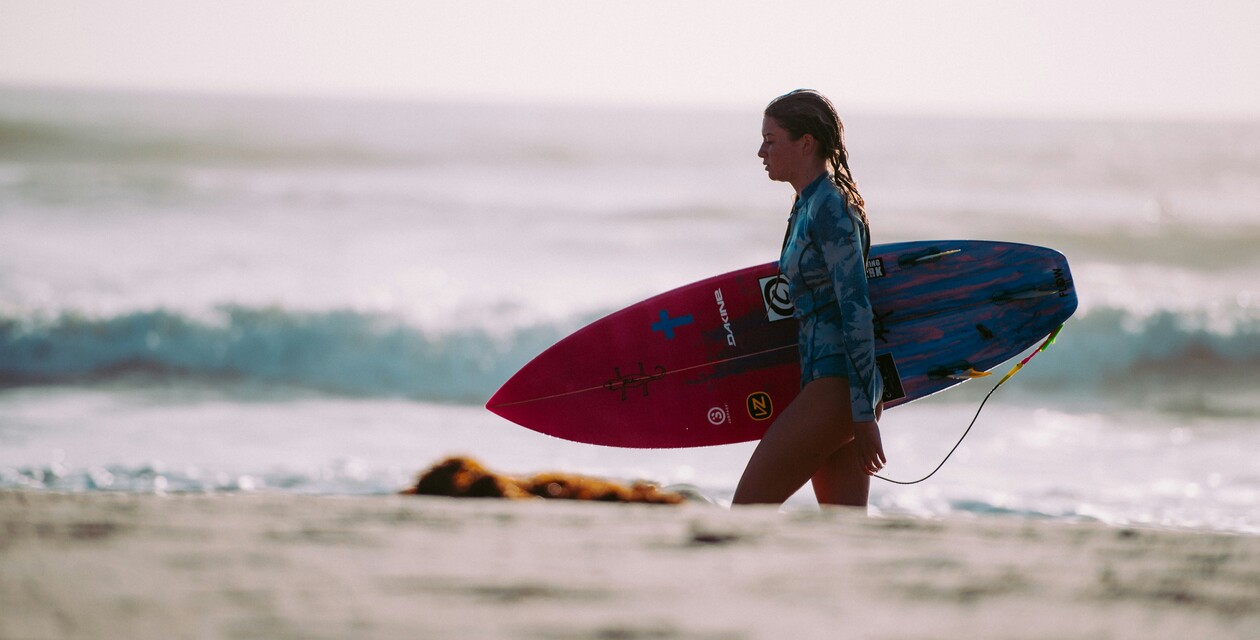
Surf movies
If you want to dream yourself into the waves from the comfort of your sofa, there are some very nice films that are all about surfing. Ideal for landlocked surfers or those who can't get enough of surfing between sessions.
The best surf books
For all bookworms, we have put together the best surf books of all time.
Surf for yourself now!
Book your place in the sun and the most beautiful waves in Europe now.
